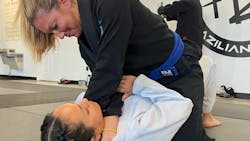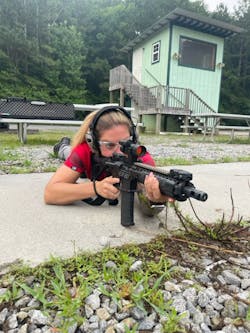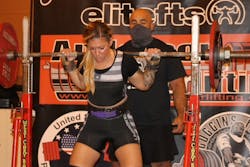Ready for the Fight
"Come back with your shield—or on it" (Plutarch, Mor.241)
I’m always preaching that law enforcement officers constantly begin in second place when it comes to responding to a suspect’s actions. That is, almost everything is reactive to what the suspect is doing at the time. If an officer is always reacting, where is there an opportunity to be proactive? It is actually embedded in the training.
The purpose of every tactical approach is slicing the pie
It is typical for agencies to practice shooting techniques on the range. Trigger time is important, and it should be foremost in the training plan. Additionally, skills like gun retention, de-escalation, negotiation, and movement should be combined with range training.
Incorporating slicing the pie is critical in firearms training. If the officer trains constantly in slicing the pie, then every approach to any location can be perceived as moving from one position of cover to another. If the officer is always reacting, then at least every movement begins and ends from cover.
I use airsoft guns and replica markers like Umarex T4E markers to train in slicing the pie. Learning to win tactically is the way to draw a straight line within an OODA loop.The purpose of every technique used on a suspect is to disrupt their ability to fight
If your handcuffing technique allows a person to maintain their balance while handcuffing, or keeps them flat-footed, you are doing it wrong. Yes, I am even talking about “compliant” arrestees.
There are several different components of an officer’s defensive posture that affect a person’s ability to continue a fight. Three of these concepts, balance, mobility, and stability, can be taken away from them during the first microsecond of physical contact. The moment an officer touches a subject, these three things need to be taken away.
How does one do it? In this article, you get to meet Amanda Bear, who practices a style of Brazilian JuJitsu (BJJ).
Some agencies are beginning to wake up to the idea that physical control training is not an annual or twice annual ticket punch. Many agencies are providing training; even others are paying their officers to train. What does this do? This type of approach shifts the culture of an agency. First, officers learn how to control suspects as a team, and individually. Second, it allows officers a chance to understand physical limitations, and capitalize on them.
For example, a reverse arm bar technique is a very effective means of taking a suspect to the ground. This is a technique where the officer grabs the wrist of the suspect and rotates it forward, while simultaneously applying pressure to the triceps tendon. If a second officer is holding the other arm, the dynamic changes. The culture shifts when officers who train together regularly learn how to do one and two-person takedowns seamlessly, and can articulate this in a use of force report.
The purpose of your training is to prepare you for the fight of your life
There are two reasons I like to use force-on-force tools. First, if the tool actually raises spots on the body that are painful, their use invariably raises the heart rate. Second, practicing things like slicing the pie can be meaningless if we cannot conduct a practical application of the task. When I was researching for the B.E.A.S.T. Training article (officer.com/21250829), I recorded sustained heart rates of 200% and higher while slicing the pie. Studies of this type of stress demonstrate that, over time, this kind of exposure improves the quality of the officer’s response. That is, stress is stress inoculation.
The same rules apply to workouts, whether they are mountain biking (strongly recommended by Lindsey), or yoga (also strongly recommended).
My apologies ahead of time if welts during training for stress inoculation raises any kind of labor issues with your agency. If you want to train for a job where one can potentially be hurt, the training will include tasks in which a person can potentially be hurt. This also means that training safety is the #1 goal.
How can agencies inoculate for stress? First, have strategies that allow for non-stress environments. That is, “off duty is off duty” and “family time is family time.” Many officers are pretty good at carving out their time and making interruptions “deal breakers.” Second, training should be physically and emotionally challenging. That is, do multi-agency force-on-force scenarios, where injured participants are evacuated through the normal chain of evacuation. For multi-echelon training, include PIOs in crafting statements, supervisors in insuring shifts are staffed, and administrators in planning sustainable operations.Train disadvantaged
If we understand that we will always be reactive, then the best approach to training is to create training scenarios where the officer is disadvantaged, then overcome them. When I talked with Amanda Bear, she told me that she sometimes goes to the range in a state of exhaustion. I’m always saying that when the conditions are questionable, it’s the best time to train.
Some things that we do regularly can be done disadvantaged. I sometimes dry fire and live fire with my gun hand bandaged. If you do this, use several kids of bandaging techniques. I use an ace bandage because it can be reused. I hold a racquetball in my hand, then wrap a bandage around it. This prevents me from grabbing anything with it, but allows the arm to be used as a rest, or for pushing off the ground. Another method is to tape a board or broomstick to it, so the object protrudes enough to make it hard to maneuver.
For officers who like to transition quickly from one training method to another, just shoot holding a kettlebell. Always include a magazine change or two in any “wounded officer” drill.
How to train: Amanda Bear
I had an opportunity to talk to Amanda Bear, a Senior Investigator with the Fulton County District Attorney’s Office in Georgia. She shared her impressive training strategies and training philosophy. She doesn’t know I was going to do this, but I think Officer.com needs to have Amanda share with us regularly, especially if it includes Amanda’s training tips. I was very inspired after talking to her. I’m certain our readers will see what I mean.
Realistic training
When I spoke with Amanda Bear she told me she had a “genetic disadvantage.” She is shorter and smaller than most of the people she encounters. Because of this, her attitude and training emphasize the importance of being body aware. Her defensive tactics and martial arts training are critical. She told me, “In order to understand body structures, you have to manipulate them.”
To be ready for the fight, she powerlifts. She has goals of keeping up her strength, and power lifts 3 to 5 times a week. She has a professional coach for her lifting. She also practices BJJ, and women’s self-defense.
I was kind of shocked when Amanda told me she has a professional coach. Her explanation is simple, and it makes sense. She told me that she makes so many decisions during her work day that adding training decisions could add more burdens. I had not thought of it that way, and it throws a new light on personal coaching.
Amanda told me that she trains BJJ, and there are several other officers that train in the same gym. One of the things that they would like to do is implement BJJ into the POST certification curriculum. I’m hoping that Georgia POST moves in this direction also, and this serves as a model for the rest of the country.
BJJ is not the only choice, but it is easily aligned with the goals of law enforcement, and one of the best choices. BJJ almost always gives students the opportunity to pit a smaller person with a larger one, which teaches leverage and technique, rather than brute force. The emphasis is control without striking, and the ability to take an opponent to the ground.
I asked Amanda about her thoughts on incorporating time at the gym with time at the range. Amanda told me that at her previous location, her gym was right next to the range. She had a good relationship with the people that owned the range, and she would lift, then run to the range and shoot. Amanda is a firm believer in incorporating workouts with range training.
In fact, she told me range training should often be done when the officer is shooting while exhausted.
We talked about adding challenges to range training. Amanda told me that she regularly trains shooting one-handed, simulating an injury, and doing firearms manipulations like reloading one-handed.
We are on the same sheet of music here. Law enforcement officers have physical demands that are unique, and these demands are often tied to emotionally draining circumstances. The way to overcome starting in second place is to train to overcome.
I asked Amanda if there was something that our readers should hear from her about training. She told me: “Train often, train hard, and train as if your life depended on it. Training is ultimately what allows me to go home.” Truer words have never been spoken.
About the Author

Officer Lindsey Bertomen (ret.), Contributing Editor
Lindsey Bertomen is a retired police officer and retired military small arms trainer. He teaches criminal justice at Hartnell College in Salinas, California, where serves as a POST administrator and firearms instructor. He also teaches civilian firearms classes, enjoys fly fishing, martial arts, and mountain biking. His articles have appeared in print and online for over two decades.


